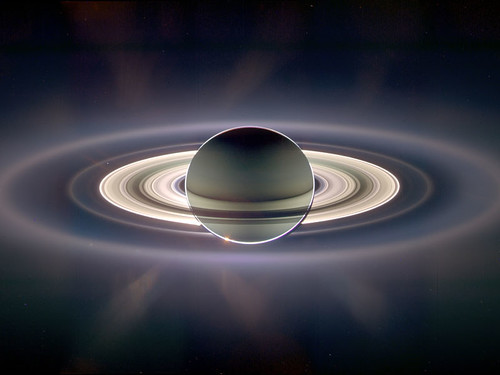In the shadow of Saturn, unexpected wonders appear. The robotic Cassini spacecraft now orbiting Saturn recently drifted in giant planet's shadow for about 12 hours and looked back toward the eclipsed Sun. Cassini saw a view unlike any other. First, the night side of Saturn is seen to be partly lit by light reflected from its own majestic ring system. Next, the rings themselves appear dark when silhouetted against Saturn, but quite bright when viewed away from Saturn and slightly scattering sunlight, in the above exaggerated color image. Saturn's rings light up so much that new rings were discovered, although they are hard to see in the above image. Visible in spectacular detail, however, is Saturn's E ring, the ring created by the newly discovered ice-fountains of the moon Enceladus, and the outermost ring visible above. Far in the distance, visible on the image left just above the bright main rings, is the almost ignorable pale blue dot of Earth.
Image: CICLOPS, JPL, ESA, NASA.
I am receiving so many gorgeous pictures from you, dear readers, that I am overwhelmed by the beauty of the images and the creatures and places in them. If you have a high-resolution digitized nature image (I prefer JPG format) that you'd like to share with your fellow readers, feel free to email it to me, along with information about the image and how you'd like it to be credited.
.


I call bogus. The rings should be in shadow, and hence invisible, as they cross Saturn's disk, and there should be no discontinuity at the edge of the disk.
Here's the link to Cassini's page for this image.
If you still think it's bogus, you can ask them. I've found the guys who work that project quite willing to talk about it. One of them comments on my blog - and has his own, According to Colwell.
Bob, the image is quite real though color contrast has been greatly exaggerated to show features. I will point out that there is light behind Saturn reflected from the rings themselves. The image is also made up of 165 photos that took three hours to take.
Cassini imaging team's page on the image: It includes the image without the color-exaggeration. You can find both images at NASA's Cassini site, but the blog's anti-spam software will not let me make the link.
Just when I think I've seen the prettiest thing there is, you post a new picture.
I prefer the true-colour version of this image. I do wonder what it says about the personality of people who pick one over the other...